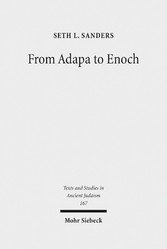Search and Find
Service
Cover
1
Preface
6
Acknowledgements
9
Contents
12
Introduction
16
I. Two Approaches to Ancient Near Eastern Scribal Cultures and their Heroes
18
1. Studies of Scribal Cultures and Techniques
18
2. Heavenly Sages and the History-of-Traditions Approach
25
3. Heavenly Sages in the Twenty-First Century: Towards Scribal Cultures in Historical Context
35
II. Ideologies of Continuity and Reinvention
36
1. Overview of the Book’s Arguments
39
Chapter 1: Heavenly Sages and the Mesopotamian Scribal Ideology of Continuity
42
I. The Ascents of Kings
43
1. The Figure of Etana
43
2. The Ascent of the King in the Ur III and Isin Periods (c. twenty-first century bce)
50
II. The Ascent of the God Dumuzi
52
III. The Ascent of the Sage
53
1. The Figure of Adapa
53
2. The Earliest Rituals and Myths about Adapa (Old Babylonian Period c. 1800–1600 bce)
54
3. The Myth of Adapa and the South Wind
56
4. The Use of Adapa by First-Millennium Kings
59
5. Adapa in Catalogues and Letters
65
6. Adapa in Incantations
66
7. Adapa in Scholarly Lists: Scribal Accounts of History, Geography, and the Divine Realm
72
8. Adapa in Myth
76
IV. A History of Adapa and the Apkall?
81
V. Conclusion
83
Chapter 2: “I Am Adapa!” The Divine Personae of Mesopotamian Scribes
86
I. Identification with Adapa and the Apkall? in Written Ritual
87
II. Our Problem with Presence
90
III. An Ancient Mesopotamian Ontology
93
IV. Persona: The Authenticity of the Exorcist’s Ritual Mask
98
V. How the Diviner Meets the Gods
104
1. The King as Diviner, the Diviner as King
109
2. The Location and Accessibility of the Divine Assembly
110
VI. Shared Cosmic Roles and Locations in Mesopotamian Ritual
112
VII. Conclusion
113
Chapter 3: Ezekiel’s Hand of the Lord : Judahite Scribal Reinventions of Heavenly Vision
118
I. Prophetic Vision as Language
119
II. Throne Visions and Problems of Knowledge
122
III. Ezekiel’s Word of the Lord: Writing as the Reader’s Loss of Prophetic Experience
126
IV. The Hand of the Lord: A Scribal Pragmatics of Divine Action
132
V. The Word of the Lord is Not Enough: From Experience to Measurement
137
VI. Conclusion
141
Chapter 4: Enoch’s Knowledge and the Rise of Apocalyptic Science
144
I. “Apocalyptic Science”? The Novelty of Ancient Judean Exact Knowledge
145
II. The Roots of Early Jewish Science in Priestly Categories and Language
153
III. How Enoch Knew: The Creation of New Scientific Genres in Second Temple Judaism
157
IV. Conclusion: Gaining Enoch’s Knowledge
164
Chapter Five: Aramaic Scholarship and Cultural Transmission : From Public Power to Secret Knowledge
168
I. Mesopotamian and Jewish Literatures Versus Babylonian and Aramaic Scribal Cultures
168
II. What Was Aramaic and Who Were Aramaic Scribes?
169
III. The Initial Pattern: Empirical Evidence for the West Semitic Adaptation of Mesopotamian Texts in Judah
171
1. From Public Power to Secret Knowledge
173
2. The Attitudes of Aramaic Scribes toward Their Material and Structural Parallels with the Attitudes of Mesopotamian Scribes
174
3. An Example of an Uncertain Case of Aramaic Scribes’ Transformation of Inherited Material
176
IV. The Broader Picture : Known Transformations of Mesopotamian Genres into West Semitic
177
1. Method
178
a. The Late Bronze Age: Direct Contact and Influence in an Ugaritic Vassal Tribute Agreement Modeled on Akkadian
181
b. The Ninth Century bce: Direct Contact and Mutual Influence in an Akkadian-Aramaic Bilingual from Anatolia
182
c. Tenth–Eighth Centuries bce: A Shared Discourse Between Luwian, Akkadian, and Phoenician Monuments for Aramean Kings in Anatolia
184
d. Eight–Seventh Centuries bce: Direct Contact and Restricted Aramaic Influence in Oath Rituals in Assyria, Syria, Anatolia and Judah
186
e. Cuneiform Legal Discourse in Biblical Law: The Covenant Code
194
f. The Assur Ostracon and the Aramaic Legal Tablets: Akkadian Influence and One-to-One Translation Techniques During the Neo- Assyrian Period
196
g. Persian Period: The Fifth-Century bce Copy of the Behistun Inscription at Elephantine
198
h. Persian Period: The Aramaic Legal Papyri from Elephantine and Wadi ed-Daliyeh
201
i. Aramaic Scholarship in Apocalyptic Literature: Astronomical Enoch and Aramaic Levi in the Hellenistic Period
203
V. The Means of Transmission
203
VI. Conclusion: The Nature of Aramaic Scribal Culture
210
Chapter 6: “Who is Like Me Among the Angels?” Judean Reinventions of the Scribal Persona
212
Introduction: Was Religious Experience an Ancient Judean Problem?
212
I. Discourse Versus Presence: A Modern Scholarly Dichotomy
215
II. Created and Commanded: An Ancient Judean Ontology
220
III. A Mask of Light
222
1. “We are Turned into the Image We Reflect :” The Reflexive Role of Enlightened One
227
IV. Lucifer’s Ascent to Heaven
229
V. Being Reckoned Divine
233
VI. Bodies of Light: A Hellenistic Jewish Scribal Worldview
236
VII. Conclusion
239
Conclusion
242
I. From Adapa to Enoch
243
II. The Relationship Between Babylonian and Judean Scribal Cultures
244
1. From Instruments of Rule to Rules of the Universe
244
2. The Parchment Period
246
III. Scribal Metaphysics and the Creation of Revealed Literature
248
1. From Religious Experience to Apocalyptic Science
248
2. Writing and Revelation Before the Supernatural
250
Bibliography
252
General Index
286
All prices incl. VAT











